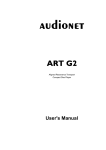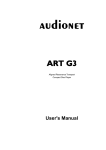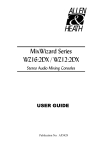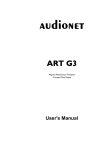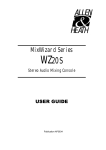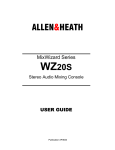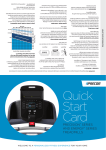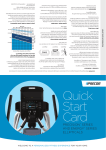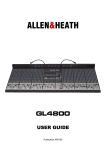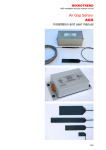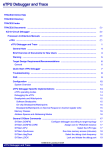Download ALLEN & HEATH WZ16:2DX User guide
Transcript
USER
GUIDE
PUBLICATION
AP2917
LIMITED ONE YEAR WARRANTY
This product has been manufactured in the UK by ALLEN & HEATH and is
warranted to be free from defects in materials or workmanship for a
period of one year from the date of purchase by the original owner.
To ensure the high level of performance and reliability for which this
equipment has been designed and manufactured please read this User
Guide before operating.
In the event of a failure notify and return the defective unit to ALLEN &
HEATH or its authorised agent as soon as possible for repair under
warranty subject to the following conditions:
CONDITIONS OF WARRANTY
1.
2.
3.
4.
5.
The equipment has been installed and operated in accordance with the
instructions in this User Guide.
The equipment has not been subject to misuse either intended or
accidental, neglect, or alteration other than as described in the User
Guide or Service Manual, or approved by ALLEN & HEATH.
Any necessary adjustment, alteration, or repair has been made by
ALLEN & HEATH or its authorised agent.
The defective unit is to be returned carriage prepaid to ALLEN &
HEATH or its authorised agent with proof of purchase.
Units to be returned should be packed to avoid transit damage.
These terms of warranty apply to UK sales. In other territories the terms
may vary according to legal requirements. Check with your ALLEN &
HEATH agent for any additional warranty which may apply.
WZ16:2 User Guide AP2917 Issue 2. copyright © 1998 Allen & Heath. All rights reserved.
This product complies with the European
Electromagnetic Compatibility Directives 89/336/EEC
& 92/31/EEC and the European Low Voltage Directives
73/23/EEC & 93/68/EEC.
MANUFACTURED IN ENGLAND
ALLEN & HEATH
Kernick Industrial Estate,
Penryn, Cornwall, TR10 9LU, UK
http://www.allen-heath.com
ALLEN & HEATH AGENT:
WELCOME TO THE ALLEN
&
HEATH
The WZ16:2 continues ALLEN & HEATH's commitment to provide high quality audio mixing
consoles engineered to meet the exacting requirements of today's audio business. It brings you the
latest in high performance technology and offers the reassurance of over two decades of console
manufacture and customer support.
This userguide presents a quick reference to the function and application of the WZ16:2. For further
information on the basic principles of audio system engineering please refer to one of the specialist
publications available from bookshops and audio equipment dealers.
Whilst we believe the information in this guide to be reliable we do not assume responsibility for
inaccuracies. We also reserve the right to make changes in the interest of further product
development.
SERVICE AND TECHNICAL SUPPORT
Under normal conditions the WZ16:2 does not require user maintenance or internal calibration. In
certain cases it may be necessary to reconfigure internal option links. This and any service work
required should be carried out by technically competent service or engineering personnel.
We are able to offer further product support through our worldwide network of approved dealers and
service agents. You can also access our Web site on the Internet for information on our product
range, assistance with your technical queries or simply to chat about matters audio... To help us
provide the most efficient service please keep a record of the console serial number, and date and
place of purchase to be quoted in any communication regarding this product.
CAUTION
Mains electricity is dangerous and can kill. Mains
voltage is present within the console. Do not remove the
covers with mains connected. To ensure your safety the
mains earth is connected to the chassis through the power
lead. Do not remove this connection.
PRECAUTIONS
•
POWER SUPPLY Check the console for correct AC mains voltage setting before switching
on. This is marked on the rear panel next to the mains input socket.
•
CONNECTIONS Use audio connectors and cables only for their intended purpose. Do not
connect any source of AC or DC power to the console audio connectors. Do not connect the output
of power amplifiers directly to the console.
•
CLEANING Avoid the use of chemicals, abrasives and solvents. The control panel is best
cleaned with a soft brush and dry lint-free cloth.
•
LUBRICATION The faders, switches and potentiometers are lubricated for life. The use of
electrical lubricants on these parts is not recommended.
•
DIRT, DUST, SMOKE and MOISTURE Prevent damage to the moving parts, such as faders
and potentiometers, and cosmetics by avoiding drinks spillage, tobacco ash, smoke, and exposure to
rain and condensation. Protect from excessive dirt, dust, heat and vibration.
•
TRANSPORTING the CONSOLE Ensure that the connector pod is secured in place with the
locking screws to prevent movement when transporting the console.
OVERVIEW OF THE
The WZ16:2 offers the professional user an uncompromised feature set and
performance for live sound engineering and recording. Built on the established
tradition of innovative British design and manufacture you get a console that is both
solidly reliable fora hard life on the road, and uniquely versatile to adapt to any audio
mixing application. The WZ16:2 is equally at home mixing alongside top end live
sound consoles such as the ALLEN & HEATH GL4000, in theatres, houses of
worship, conference and club installations, home and recording studios, or multitasking in equipment hire companies. Check out the key features:
•
16 channel inputs for microphone or line sources
Wide 70dB gain range for loud and soft sources.
Balanced XLR and jack both accept mic or line signals.
+48V phantom power switchable to the XLR inputs. 4band EQ with 2 mid frequency sweeps.
100Hz lo-cut filter to remove mic popping and stage rumble.
Channel inserts for plugging in signal processors.
Channel direct outputs for multitrack recording.
6 Aux sends with up to 6dB boost, for 2 pre-fade monitor sends, 2 switched
pre or post-fade for monitors or effects, and 2 post-fade for effects sends,
recording or broadcast.
Peak LED indicator to warn of signal overload.
100mm long travel faders for smooth control.
•
2 stereo return inputs for effects and replay
With separate level to L-R and to Aux 1 for the monitor.
•
L-R main output
Balanced XLRs with inserts and individual 100mm faders.
•
Extra A-B output
For additional L-R stereo or L+R mono output selectable pre or post L-R
faders. Unique underpanel mode switch to configure A-B as a local
monitor output for additional stereo or mono monitoring.
•
Engineers monitoring independent of the main outputs
Stereo headphones output with auto PFL indicated by a large red LED
Monitor switchbank with priority override to select each Aux, Stereo return
or L-R (pre or post fader). Auxes can be listened to in stereo pairs.
•
QCC Quick Change Connector system
Simply hinge the connector pod into position for 1 9"rack or desk operation.
•
MSP Minimum Signal Path for audio transparancy
Carefully designed circuitry to keep the signal path from input to output
short using high grade, low noise discrete and IC components.
•
Rugged all metal construction
Individual circuit assemblies with all rotaries securely bolted to the panel.
No nonsense solid build to ensure on the road reliability.
Here are a few typical WZ16:2 applications. For clarity, the input sources,
signal processing such as EQ, and the amplifiers are not shown:
PA with Live Recording - Typical of the up-andcoming band playing the small venue. Simultaneous
stereo and multitrack recording for the demo tapes.
Extended Speaker System - Typical in a theatre
with a wide stage, and a disco/club. Here, the A-B
outputs feed a centre fill speaker and a sub-bass for
extended low frequency performance. L and R are
combined in mono to drive the centre speaker. Using
sub-bass, less power is needed in the L,C,R speakers.
Studio or Location Recording - Multitracking up to
16tracks with stereo mastering and recording. Stereo
cue for the performers, and plenty of effects.
Small Theatre - Typical amateur dramatics setup
with delay speakers compensating for acoustic delay
and improving clarity to the rear of the hall. CD
intermission replay, 2-track recording for the
performers.
Houses of Worship - Increasingly sophisticated
sound control is required. Here, a music PA is
controlled using L-R, and the congregation PA with
delay compensation separately controlled using A-B.
Dedicated Stage Monitor - This example shows 4
floor wedges for the musicians and a stereo in-ear
monitor for the lead performer. The engineer monitors
the signals using a floor wedge similar to the stage
monitors.
INSTALLING THE CONSOLE
The MixWizard Series features the ALLEN & HEATH Quick Change Connector
(QCC) system. The rear connector pod may be hinged and locked into either
of two positions: Rear connectors for desktop operation with the control panel
sloped at a convenient 15 degrees, or Underside connectors for 19" rack
mounting in a compact 10U space. The connector position can be easily
changed at any time to fit your application.
To change the position
remove the crosshead
locking screw on each side,
swing the connector pod
into position, and refit the
two screws.
Do not transport or carry the
console with the locking screws
removed.
Do not attempt to remove the
connector pod from the console.
19" RACK MOUNTING
Not Suitable For In-Wall Mounting
101.6
193
165.1
443.7
(10U)
101.6
37.7
Using
a
suitable
screwdriver, mount the
console in the rack using
4x M6 bolts and M6 caged
nuts on each side for
maximum strength. We
recommend you fit the
bolts with plastic cup
washers to protect the
panel. Ensure adequate
ventilation by allowing a
minimum clearance of
25mm around all sides for
unimpeded air flow.
FLIGHTCASING
The console can be easily
flightcased in either
connector mode. Provide
the dimensions shown here
to your flightcase supplier.
482.6 (19"RACK)
75
DESKTOP OPERATION
13
192
65
6
The console is fitted with rubber
feet to ensure it does not slip or
scratch the work surface. The
control panel is angled at 15
degrees for operating convenience.
WZ16:2 USER GUIDE
CONNECTING MAINS POWER
Refer to the SAFETY WARNING on page 3 of this User
Guide. Check that the voltage indicated on the rear panel is
the same as the mains supply in your area. Check that the
correct mains lead with moulded plug has been supplied with
your console. Read and understand the warnings and
instructions printed on the rear panel and shown here.
It is standard practice to turn connected power amplifiers
down or off before switching the console on or off. Ensure
that the IEC mains plug is pressed fully into the rear panel
socket before switching on.
EARTHING
The connection to earth (ground) in an audio system is important for two reasons:
1. SAFETY - To protect the operator from high voltage shock associated with the AC
mains supply feeding the system,
and
2. AUDIO PERFORMANCE QUALITY - To minimise the effect of earth (ground) loops
which result in audible hum and buzz, and to shield the audio signals from interference.
For safety it is important that all equipment earths are connected to mains earth so that
exposed metal parts are prevented from carrying high voltage which can injure or even
kill the operator. It is recommended that the sound engineer check the continuity of the
safety earth from all points in the system including microphone bodies, guitar strings,
muticore cases, equipment panels ...
The same earth is also used to shield audio cables from external interference such as the
hum fields associated with power transformers, lighting dimmer buzz, and computer
radiation. Problems arise when the signal sees more than one path to mains earth. An
'earth loop' (ground loop) results causing current to flow between the different earth paths.
This condition is usually detected as a mains frequency audible hum or buzz.
To ensure safe and trouble-free operation we recommend the following :
l
Do not remove the earth connection from the mains plug. The console chassis
is connected to mains earth through the power cable to ensure your safety. Audio 0V is
connected to the console chassis internally. If problems are encountered with earth loops
operate the audio 'ground lift' switches on connected equipment accordingly, or disconnect
the cable screens at one end, usually at the destination. It is useful to carry ground lift
cable adaptors such as short XLR male to female leads with pin1 disconnected.
l
Avoid running audio cables next to mains, computer or lighting cables, or
near thyristor dimmer and power supply units. If unavoidable, cross these at right angles.
l
Use low impedance sources such as 200 ohm or less microphones to reduce
susceptability to interference. The console outputs are designed to operate at very low
impedance to minimise interference problems.
l
Use balanced connections where possible as these provide further immunity
by cancelling out interference that may be picked up on long cable runs. To connect an
unbalanced source to a balanced console input, link the cold input (XLR pin3 or jack ring)
to 0V earth (XLR pin1 or jack sleeve) at the console. To connect a balanced console
output to an unbalanced destination, link the cold output to 0V earth at the console.
l
Use professional quality cables and connectors and check for correct wiring
and reliable solder joints.
l
If you are not sure ... Have your system checked by a competent engineer, or
contact your local Allen & Heath agent for advice.
WZ16:2 USER GUIDE
7
PANEL LAYOUT
SPECIFICATIONS
0 dBu = 0.775 Volts rms
HEADROOM: .............................. +21dB channels
+23dB mix to output
MAX OUTPUT:............................. XLR +27dBu 600 ohm max load
jack +21dBu 2kohm max load
METERS: ........L, R...................... peak reading 12 segment LED
0 dBV = 1 Volt rms
CROSSTALK: Referred to driven channel at 1kHz
Channel fader off................................................<-90dB
Channel off
<-90dB
NOISE: Measured rms 22Hz to 22kHz bandwidth
Mic input EIN referred to 150 ohm source .........<-128dB
LR output residual noise.....................................<-97dBu 101dB S/N
LR faders unity mix noise ..................................<-84dBu 88dB S/N
PEAK LEDs: ................................ Turn on 5dB before clipping
FREQUENCY RESPONSE: 20Hz to 50kHz +0/-1dB
DISTORTION: THD+Noise at +14dBu 1kHz
Channel to mix output.........................................0.008%
WEIGHT: unpacked 12kg, packed 14kg
POWER SUPPLY:........................ internal
AC Mains input:
IEC socket with lead supplied
100 to 240V AC @ 50/60Hz
factory wired to country voltage
Power consumption...................... 30W max
Mains Fuse rating: ....................... 100-120VAC use T630mA 20mm
220-240VAC use T315mA 20mm
CONNECTIONS
INPUTS:
Channel 1-16 IN ............. XLR............................pin 2 hot, 3 cold, balanced
TRS jack.....................tip hot, ring cold
PAD out ............ 2 k ohm .......... variable -60 to -20dBu
PAD in ............... >10k ohm........ variable -30 to +10dBu
Stereo Return IN..............TRS jack.....................tip hot, ring cold ........................ >10k ohm........-10dBV (+4dBu option)
INSERTS:
Channel 1-16 Insert......... TRS jack....................tip send, ring return, unbal .................... <75 ohm, >10k ohm.... 0dBu
L-R mix ............................ TRS jack....................tip send, ring return, unbal .................... <75 ohm, >10k ohm.... -2dBu
OUTPUTS:
L-R main OUT ................XLR ............................ pin 2 hot, 3 cold, balanced ....................<75 ohm ..........+4 dBu
A-B additional OUT.........TRS jack..................... tip hot, ring cold, impedance bal ............<75 ohm ..........-2dBu
Aux 1-6 OUT...................TRS jack..................... tip hot, ring cold, impedance bal ............<75 ohm ..........-2dBu
Balance option for A -B and Aux 1-6 OUT ................................. <75 ohm...........+4dBu
Direct 1-16 OUT .............TRS jack..................... tip hot, ring cold, impedance bal ............<75 ohm ..........0dBu
PHONES OUT................TRS jack..................... tip left, ring right ........... for stereo headphones 30 to 600 ohms
PLUGGING UP THE CHANNELS
The MixWizard Series uses professional grade 3-pin XLR and 1/4" TRS jack sockets.
We recommend that you use suitable quality cable and connectors and check your
leads for reliable soldering and continuity before use. It is well known that most audio
system failures are due to faulty interconnecting leads.
PHANTOM POWER
CHANNEL INPUTS
Both microphone and line
sources such as keyboards, replay devices and effects processors can
be plugged into either the jack or XLR input for convenience. The
channel accepts a wide 70dB range of source levels. The input is a
balanced 3-wire to provide the best immunity to interference pickup on
long cable runs. However, you can plug in an unbalanced 2-wire source
simply by linking the input - (cold) connection to ground (XLR pin3 to pin
1, jack ring to sleeve) in the connector plug.
Press the underpanel
48V switch if you are using
microphones which
require phantom power.
This feeds +48V to pins 2
and 3 of the XLR inputs.
Ensure that you use
balanced leads. Note that
you can use non powered
balanced mics in
powered sockets without
damage. 48V does not
feed the jack inputs.
CHANNEL INSERT
You do not need to plug anything into the channel insert socket for normal operation.
However, you may wish to insert a signal processor such as a compressor/limiter or
noise gate into the channel signal path to prevent excessive peaks or to cut down
source noise. The insert lets you do this by breaking the signal path after the input preamp and before the EQ. Use a Y-lead or suitable TRS jack lead to connect to the
external processor. The insert operates at 0dBu line level. Adjust the processor input
and output levels for optimum signal level.
DIRECT OUTPUT
The channel direct output taps the signal off post-fader (pre-fader if the internal link
options is changed) for connection to external processing or recording equipment. This
is ideal for multitrack recording during live performance. Here each channel can be
recorded on a separate track for mixdown later. The output is impedance balanced on
TRS jack. That means that you get the benefit of interference immunity when
connecting to a balanced input. You can, of course, also connect to unbalanced
equipment. The signal operates at nominal 70dB line level.
PLUGGING UP THE OUTPUTS
L-R MIX
INSERTS
L-R MAIN
OUTPUTS
Use these sockets if you wish to insert external signal processing equipment into the LR mix post-mix amp and pre-L-R fader. This lets you check the effect of the inserted
equipment using the console headphones or local monitor. For live sound it is
common to insert graphic equalisers to adjust for the room acoustics. In recording you
could plug in a compressor to prevent unexpected peaks overloading the recording.
Use a suitable stereo jack lead or Y-adaptor for tip = send, ring = return.
These outputs are 3-wire balanced XLR operating at a nominal +4dBu to drive
professional equipment over long cable runs without interference pickup. You can,
however, connect to 2-wire unbalanced equipment inputs by linking signal - (cold) to
ground (XLR pin3 to pin1). Connect to an amplifier of suitable power rating for the
venue to drive the PA loudspeakers. Or connect to a 2-track recorder for studio or
location recording.
STAGE MONITOR
AND CUE SENDS
Set up a pre-fade aux mix to
send a monitor or cue mix to the
performers. The aux outputs
are 3-wire impedance balanced
for interference rejection when
plugged into balanced
equipment inputs. You could
insert a graphic EQ between the
output and the amplifier for
monitor feedback control.
EFFECTS SEND
AND RETURN
2-TRACK REPLAY
Plug your 2-track recorder into a stereo
return to monitoryour recording, or for
replay over the PA. The return can
also be used for intermission replay
from a CD player or similar.
Set up a post-fade aux mix to send
channel signals to an external effects
device such as reverb or delay. Return
the processed signal to the mix by
plugging the device output into ST1 or
ST2 stereo return, or into a channel
input. These inputs can operate
balanced or unbalanced. For a mono
return simply plug into the L input leaving
R unplugged. The setting of the channel
aux send control determines how much
effect is added to the signal.
INPUT CHANNEL
PAD - Attenuates the input signal by 30dB. Affects both the XLR and
jack inputs. Press this switch when the input signal is too high even with
the GAIN control backed off.
GAIN - Use this control with the PAD switch to adjust the channel input
sensitivity to match the connected source (-60 to +10dBu) to the console
operating level (0dBu). Use the PFL function to check that the signal
reads an average '0' on the meters.
100Hz LO -CUT FILTER - Attenuates frequencies below 100Hz to
reduce lowfrequency source noise such as microphone proximity popping,
stage noise and transport rumble. Can be used to clean up sounds that
do not have much bass content such as vocals.
EQUALISER - This provides separate, simultaneous control of 4
frequency bands. Each band may be boosted or cut by up to +/- 15dB.
The centre flat position is detented for quick resetting.
The HF and LF bands have a shelving response which means that all
frequencies beyond the turning pointfrequency are affected, HF = 12kHz,
LF = 60Hz. Use HF to add sparkle or to reduce source hiss. Use LF to
add punch to the bass instruments. Used with the LO-CUT filter you can
tailor the low frequency response exactly as you require.
The two mid frequency bands have a peak/dip (bell shaped) response
which means that the maximum boost or cut occurs at the selected
(centre) frequency. The centre frequency can be swept over a wide range
using the SWEEP controls. MF1 = 500Hz to 15kHz, MF2 = 35Hz to 1kHz.
Use the mids to add warmth or presence to the sound or to notch out
problem resonances that can result in feedback.
AUXILLIARY SENDS - You can set up to 6 separately balanced mixes
using the aux send controls. Up to +6dB of boost is available.
Aux 1 and 2 are set pre-fader for monitor sends such as stage monitors,
backstage, orchestra pit, and musicians recording cue. The amount of
channel signal in the monitor mix is independent of the fader level. Prefade sends are post-EQ, post-ON as standard (can be reconfigured preEQ or pre-ON by setting internal links).
Aux 3 and 4 are switched pre or post fader for more monitors, effects or
separately balanced feeds for recording and broadcast.
Aux 5 and 6 are set post-fader for sends to external effects devices such
as reverb and delay. The amount of signal sent to the effects device
follows the fader level and ON switch. The processed ("wet") signal
returned to the mix through the aux return inputs is therefore in proportion to
the direct ("dry") signal from the fader to the mix.
PAN - Positions the channel signal between L and R in the stereo mix.
The centre position (mono image) is detented for quick resetting.
ON - This turns the channel signal on or off.
PEAK - The red LED lights when the signal is within 5dB of clipping.
Should this occur turn back the GAIN control to reduce the signal level.
PFL - Press PFL to listen to the pre-fade signal on headphones or local
monitor without affecting the main outputs. The signal level is shown on
the L and R bar meters. The PEAK LED half lights to show which channel
PFL has been selected.
STEREO RETURNS
Two stereo return inputs ST1 and ST2 are provided giving you a
total of 20 inputs to the L-R mix. These may be used for returning
the processed signal from the effects devices, monitoring and
replaying your 2-track recording, expander or submix inputs, or for
stereo intermission replay.
AUX1 LEV - Sends the return signal (L and R combined into
mono) to the Aux1 mix independent of the level to the main mix.
This lets you feed effects to the performers monitor. When using
the return for 2-track replay you can replay the recording to the
performers cue. Up to +6dB boost is available.
L-R LEV - Adjusts the return signal level to the L-R mix.
MASTERS
AUX MASTERS - Each aux mix has a master level control that
adjusts the output level to match external equipment, or to trim the
monitor, effect or recording level without affecting the mix balance.
Up to +4dB of boost is available above the nominal '0' position.
L-R FADERS - Individual 100mm faders adjust the main L-R mix
level with +10dB boost available above the nominal '0' position. For
best performance the faders should be operated around the '0'
position for normal 'loud' level. If you find yourself operating
significantly below '0' then the amplifier or recorder input is too
sensitive for the console +4dBu output. Simply turn down the
amplifier or recorder level trim. If none is available then insert an
attenuator pad between the console and connected equipment.
MONITOR
PFL - A large red LED lights when any channel PFL switch is
pressed. The PFL signal overrides any selected monitor source.
MONITOR SWITCHBANK - 9 switches select which source you
listen to on the headphones and view on the L, R meters. These
include Aux1-6, ST1and ST2 in stereo, and L-R. It is useful to be
able to turn off L-R in the monitor so that headphones spill does not
cause a distraction during live mixing.
Priority works from the top of the switchbank down as follows: PFL
interrupts Aux, interrupts ST1, interrupts L-R
For example, you can select L-R to monitor your mix, then press
ST1 to interrupt L-R with your 2-track replay, then press an Aux to
check a monitor. Pressing any PFL always takes priority.
Auxes can be monitored in mono or as combined stereo pairs. For
example, press Aux1 for mono, press Aux1 and Aux2 together to
monitor Aux1-2 as a stereo pair. Pressing Aux3 overrides the
Aux1-2 monitoring, and so on. This is most useful when you set up
stereo cue or recording sends.
L-R POST/PRE - This switch is recessed to prevent accidental
operation. It should be operated with a pen tip or other sharp object.
In the normal up position pressing the L-R monitors the main mix
post-fader. When down, L-R is monitored pre-fader so that you
can monitor the mix unaffected by the L-R fader positions.
OPTIONS
The MixWizard Series WZ16:2 has a versatile architecture designed to satisfy most
live sound or recording applications you may encounterwithout modification. However,
the following internal options are offered to provide alternative settings for those
applications that may demand them. These options require resoldering of circuit board
links and should only be carried out by competent technical personnel. Further
information is available from your service agent or the WZ16:2 SERVICE MANUAL.
PHANTOM POWER DISABLE
It is perfectly safe to connect non-phantom powered sources such as dynamic
microphones to powered XLR sockets providing that balanced leads and sources are
used. The +48V supply is current limited through 6.8k ohm resistors to each XLR to
prevent damage. However, you can disable phantom power to selected channels by
cutting out links on the rear connector circuit assembly. This work should be referred to
your service agent.
ST1, ST2 INPUT SENSITIVITY
The stereo return inputs are set for nominal low level -10dBV operation as is common
with much of the external equipment available today. The console level controls let you
adjust for varying input levels. Most outboard equipment include output level trims. If,
however, you wish to change the sensitivity to high level +4dBu the rear connector
circuit can be reconfigured. This work should be referred to your service agent.
AUX OUT AND A-B OUT BALANCE OPTION
These outputs are impedance balanced on TRS jack to provide interference rejection
when plugged into equipmentwith balanced inputs. It should not normally be necessary to
fit the electronic balance option available. This option also increases the output level to a
nominal +4dBu. Refer this work to your service agent.
CHANNEL PRE-FADE AUX SEND OPTIONS
The pre-fade sends are set post-EQ and post-ON as standard. However, link options on
each channel assembly allow pre-EQ and/or pre-ON if required. This is shown in the
diagram below.
CHANNEL DIRECT OUTPUT SOURCE
The direct outputs are sourced post-fader as standard. A link option is available per
channel to select a pre-fade source. This is shown in the diagram below.
A- B O U T P U T
The A-B output is an additional stereo/mono output that can be
uniquely configured as either a separately controllable mix
output, or a local loudspeaker monitor feed.
MODE SWITCH - This switch is recessed under the panel to
prevent accidental operation. It is operated using a pen tip or
similar pointed object. In the normal up position A-B follows the
main L-R mix. When pressed A-B follows the monitor switchbank +
PFL to become a 'local' monitor in addition to the headphones.
POST/PRE - This recessed switch selects whether the L-R signal
fed to A-B is sourced pre or post the L-R faders.
LEVEL - Adjust the output level using this control. Up to +10dB of
boost is available above the nominal '0' position.
MONO - Sums L+R into mono. When A-B is configured as an
additional mix output the MONO switch provides a mono output
ideal for centre fill or sub-bass loudspeaker systems, or mono
recording and broadcast feeds. When A-B is configured as a local
monitor the MONO switch lets you check the mono compatibility of
the selected mono source. Alternatively you can feed a local mono
speaker monitor such as an engineers listen wedge.
Here are a few applications of the versatile A-B output:
L-R stereo live recording / broadcast
mode = up, set pre-fade
level trim to match recorder, L and R out
Mono live recording / broadcast
mode = up, set pre-fade, mono selected
level trim to match recorder, 2x M out
Additional L-R zone speakers
mode = up, set pre or post fade
level trim to balance speakers, L and R out
L-R delay fill speakers
mode = up, set post-fade
level trim to balance to main, L and R out
Mono centre fill speaker
mode = up, set post-fade, mono selected
level trim to balance to main, 2x M out
Sub-bass speaker
mode = up, set post-fade, mono selected
level trim to balance to main, 2x M out
Local stereo speaker monitor
mode = down
separate monitor level, L and R out
Local floor listen wedge monitor
mode = down, mono selected
separate monitor level, 2x M out
















